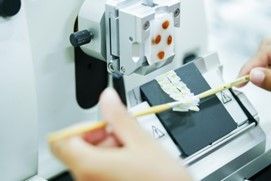FFPE DNA Purification (Automation)
NeoGeneStar™ EZ FFPE DNA Purification Kit
For Isolation of DNA from FFPE Samples and For Automation on Thermo KingFisher Flex
$498

Product Description
NeoGeneStar™ EZ FFPE DNA Purification Kit is designed for fast and convenient purification of DNA from FFPE tissue or sample fixed in formaldehyde. Elimination of dewaxing step and toxic reagents such as xylene, phenol, chloroform allows an environmentally-friendly procedure. The high quality eluted DNA is ready for use with a broad range of downstream assays, such as PCR, qPCR, quantitative real-time RT-PCR and next-generation sequencing. This product is designed for either manual extraction or automated instruments such as King Fisher or Hamilton (protocol for automation is written separately).
EZ Experiment Procedure
Sample
Add 300 μL Pretreatment Buffer (Buffer CRS) + 10 μL proteinase K
Incubate 56℃ for 2 hr
Incubate 90℃ for 1 hr
Centrifuge
Add 400 μL Buffer LWA
Add 200 μL Isopropanol
Add 20 μL DNA FFPE Beads
Wash with 600 μL Buffer WB
Wash 2X with 600 μL Buffer SPW
Air dry 10 minute
Add 50-100 μL Elution Buffer
65℃ for 10 minutes
Purified genomic DNA
Main components
For RNA Purification
| Components | NGS2015-01 (50 tests/kit) | NGS2015-02 (100 tests/kit) |
|---|---|---|
| Pretreatment Buffer (Buffer CRS) | 15 mL/ Bottle | 30 mL/ Bottle |
| Lysis Buffer *1 (Buffer LWA) | 20 mL/ Bottle | 40 mL/ Bottle |
| DNA Washing Buffer2 *1 (Buffer WB) | 30 mL/ Bottle | 60 mL/ Bottle |
| DNA Washing Buffer 2 (Buffer SPW) (Concentrated) | 10 mL/ Bottle | 20 mL/ Bottle |
| FFPE DNA Beads | 1 mL/Vial | 1 mL/ Vial * 2 |
| DNA Elution Buffer (Buffer TE) | 5 mL/ Bottle | 10 mL/ Bottle |
*1 Binding Buffer and Wash Buffer contain chaotropic salts, which are irritants. Please wear gloves and handle with appropriate laboratory safety measures.
*2 Absolute ethanol must be added prior to use for the Wash Buffer.
Materials Needed That Are Not Supplied
- Low DNA binding microcentrifuge tubes or 96 deep well plate
- Magnetic separation devices (for 1.5ml and 96 well microtiter plate)
- Absolute ethanol and isopropanol
- Tube shaker / vortexer for 96 well plate and microcentrifuge tubes.
- Thermo KingFisher Flex
Storage conditions and expiration period
- Store all buffers at room temperature (15-30°C) and away from light.
- FFPE RNA Beads and FFPE RNA Beads can be stored at room temperature (15-30℃) when unopened, after opening, store in a refrigerator (2-8℃).
- DNse Ⅰ dry powder should be stored in a refrigerator (2-8°C) before adding DNase Dissolve Buffer; after adding DNase Dissolve Buffer, aliquot and store at -20°C, avoid repeated freezing and thawing.
- The kit content is stable for 12 months after the manufacture date.
Reagent Preparation
- Automated extraction instrument: UV disinfection before use.
- Buffer check: Before use, please make sure that no crystals precipitate in the Pretreatment Buffer (Buffer CRS) and Lysis Buffer (Buffer LWA). If there are crystals precipitations, redissolve the crystals in a 37°C warm bath.
- Absolute Alcohol and Isopropyl alcohol are required for the experiment.
- Set temperature of water bath to 56°C or 90°C. 5. Reagent preparation:
- Prepare 85% ethanol solution.
- Preparation of 1x Washing Buffer 2 (Buffer SPW) according to table below (mark the box on the label after adding absolute ethanol).
| Catalog Number | Add Absolute Alcohol Volume |
|---|---|
| NGS2015-01 (50 tests/kit) | 50 mL |
| NGS2015-02 (100 tests/kit) | 100 mL |
Samples Preparation and Pretreatment
- Prepare the FFPE samples for DNA purification process:
- FFPE sections: Take 5-8 FFPE tissue sections. The thickness of each section is between 5-10 μm and the surface area is 1×1 cm2.
- FFPE tissue block: Take about 30 mg of FFPE tissue and use a sterile scalpel to remove excess paraffin outside the selected sample area.
- Sample fixed in formaldehyde: Take about 30 mg of sample, cut it into several pieces with a scalpel, then put the sample into a 1.5-2ml centrifuge tube, add 400μl PBS (10 mM, pH7.4), centrifuge at 12000 rpm for 1 min, repeat 3 times.
- Put sample into a 1.5 mL or 2 mL centrifuge tube, add 300 μL Pretreatment Buffer (Buffe CRS) and 10 μL proteinase K (20mg/mL), vortex to mix, and incubate at 56°C for 2 hours, then 90°C for 1 hours.
- Centrifuge at room temperature (≥12000 rpm) for 10 minutes, take tube out, there is clearly three layers, middle layer contains DNA, top layer contains wax and proteins, and bottom layer contains tissue debris. Carefully transfer 300μl of supernatant from the middle layer to a new microcentrifuge tube for the DNA purification.
Automated DNA Isolation Procedures
- Take 300 μL of the supernatant in step 3 above into a new 2 mL microcentrifuge tube and incubate at 80°C for 15 minutes, then centrifuge briefly and transfer all the supernatant to a new 1.5 mL-2 mL centrifuge tube.
- Add 650 μL of 1× Buffer FBR and 40 μL of FFPE RNA beads, vortex to mix, and incubate at room temperature for 5 minutes, mix every 2-3 minutes to aid lysis and binding. Note: Magnetic beads tend to sink to the bottom, please resuspend the FFPE RNA beads by vortexing for 1 minute, then add 30μl of FFPE RNA beads.
- Place the microcentrifuge tube on a magnetic stand for about 30 seconds or until the solution clears, turn the tube over a few times while on the magnetic stand to remove the FFPE RNA beads trapped on the lid. With the sample tube on the magnetic stand, carefully aspirate the cleared supernatant without aspirating the FFPE RNA beads.
- Add 700 μL of 1× Buffer FWR1, and vortex for 1-2 minutes to completely resuspend the magnetic beads.
- Place the microcentrifuge tube on a magnetic stand for about 30 seconds or until the solution clears, turn the tube over a few times while on the magnetic stand to remove the FFPE RNA beads trapped on the lid. With the sample tube on the magnetic stand, carefully aspirate the cleared supernatant without aspirating the FFPE RNA beads.
- Add 140 μL DNase Reaction Buffer (Buffer FWR2) and 6 μL DNase I (DNase I), mix gently with a pipette, centrifuge briefly to collect the solution to the bottom of the microcentrifuge tube, and incubate at room temperature for 20 minutes.
- Place the microcentrifuge tube on a magnetic stand for about 30 seconds or until the solution clears, turn the tube over a few times while on the magnetic stand to remove the FFPE RNA beads trapped on the lid. With the sample tube on the magnetic stand, carefully aspirate the cleared supernatant without aspirating the FFPE RNA beads.
- Remove the microcentrifuge tube from the magnetic separation rack, add 800 μL of 85% ethanol to wash, and vortex for 1-2 minutes to completely resuspend the magnetic beads.
- Place the microcentrifuge tube on a magnetic stand for about 30 seconds or until the solution clears, turn the tube over a few times while on the magnetic stand to remove the FFPE RNA beads trapped on the lid. With the sample tube on the magnetic stand, carefully aspirate the cleared supernatant without aspirating the FFPE RNA beads.
- Repeat steps 8 and 9.
- Pulse down and aspirate again to remove as much of the liquid as possible. Keeping the microcentrifuge tube on the magnet, air-dry the FFPE RNA beads at room temperature for 10 minutes. Note: Do not vacuum dry, excessive drying will reduce recovery rate.
- Add at least 60 μL of RNA Eluent Buffer (RNase-Free H2O), vortex or pipet 10 times to fully resuspend the magnetic beads and incubate with shaking at 45°C for 5 minutes.
- Place sample tubes on a magnetic stand, the solution will clear in about 1 minute. Transfer the cleared supernatant into a low RNA binding microcentrifuge tube. This is the purified RNA. Freeze the eluted RNA until you are ready for your downstream analysis.
DNA Extraction process
Take out the 96 deep well plate (NGS2015-A96) and add reagents and samples according to the information in the table below (if it is a bottled kit, the customer needs to add all of buffer into 96 deep well plate).
| 96 well plate | Plate Position | Reagents | Volume | Comment |
|---|---|---|---|---|
| Binding plate | 1 | Buffer LWA | 400μL | |
| Isoproponol | 200μL | Customer need to add | ||
| Sample | ≤400μL | Customer need to add | ||
| Wash 1 plate | 2 | Buffer WB | 600μL | |
| Wash 2 plate | 3 | Buffer SPW | 600μL | |
| DNA FFPE Beads | 20μL | |||
| 96 Tip Comb | ||||
| Wash 3 plate | 4 | Buffer SPW | 600μL | |
| Elution plate | 5 | Elution Buffer (Buffer TE) | 80μL |
- Add 400 μL of DNA Binding Buffer (Buffer LWA) and 200 μL of isopropanol.
- Vortex the FFPE DNA Beads for 1 minute to fully resuspend and add 20 μL FFPE DNA Beads to the microcentrifuge tube, vortex constantly, or pipet 10 times to mix the FFPE DNA Beads thoroughly, incubate at room temperature for 10 minutes, shake for 1 minute every 3 minutes to help lysis and binding.
Note: Magnetic beads tend to sink to the bottom, resuspend the FFPE DNA beads by vortexing for 1 minute, then add 20μl of FFPE DNA beads. - Place the microcentrifuge tube on a magnetic stand for about 30 seconds or until the solution clears, turn the tube over a few times while on the magnetic stand to remove the FFPE DNA beads trapped on the lid. With the sample tube on the magnetic stand, carefully aspirate the cleared supernatant without aspirating the FFPE DNA beads.
- Remove the microcentrifuge tube from the magnetic separation stand, add 600 μL Washing Buffer (Buffer WB), and vortex for 1 min to completely resuspend the magnetic beads.
- Place the microcentrifuge tube on a magnetic stand for about 30 seconds or until the solution clears, turn the tube over a few times while on the magnetic stand to remove the FFPE DNA beads trapped on the lid. With the sample tube on the magnetic stand, carefully aspirate the cleared supernatant without aspirating the FFPE DNA beads.
- Remove the microcentrifuge tube from the magnetic separation rack, add 600 μL of 1x Buffer SPW, vortex for 1 minute to completely resuspend the magnetic beads.
- Place the microcentrifuge tube on a magnetic stand for about 30 seconds or until the solution clears, turn the tube over a few times while on the magnetic stand to remove the FFPE DNA beads trapped on the lid. With the sample tube on the magnetic stand, carefully aspirate the cleared supernatant without aspirating the FFPE DNA beads.
- Repeat steps 6 and 7.
- Pulse down and aspirate again to remove as much of the liquid as possible. Keeping the microcentrifuge tube on the magnet, air-dry the FFPE DNA beads at room temperature for 10 minutes. Note: Do not vacuum dry, excessive drying will reduce recovery rate.
- Add at least 80 μL of DNA Elution Buffer (Buffer TE), vortex or pipet 10 times to fully resuspend the magnetic beads and incubate with shaking at 65°C for 10 minutes. Note: The elution effect depends on the pH of the eluent. Maximum elution efficiency is obtained at a pH between 7.0-8.5. Make sure the pH is within this range when eluting with water, and store the eluted DNA at -20°C.
- Place the microcentrifuge tube on the magnetic separation rack. After the solution clears, transfer all the supernatant to a clean microcentrifuge tube and store eluted DNA under appropriate conditions.

